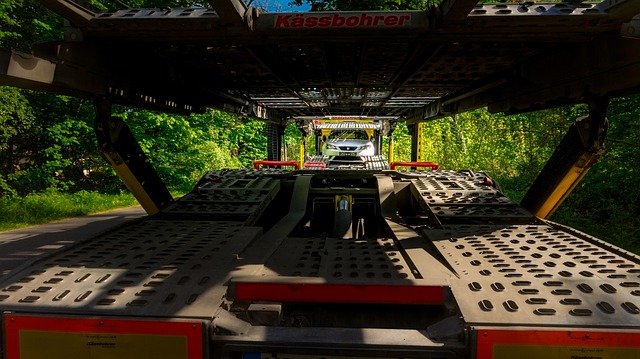Learn how to register your car in California with our step-by-step guide. This comprehensive process involves understanding state requirements, gathering essential documents, scheduling an appointment at your local DMV office, and completing the registration using a DMV VIN verifier. We’ll also walk you through verifying and maintaining your vehicle’s registration status post-registration. Ensure a smooth experience by following these crucial steps.
- Understand California Vehicle Registration Requirements
- Gather Necessary Documents for Car Registration
- Locate Your Local DMV Office and Make an Appointment
- Complete the Registration Process at the DMV Using VIN Verifier
- Verify and Maintain Your Vehicle's Registration Status Post-Registration
Understand California Vehicle Registration Requirements

Before registering your car in California, it’s crucial to understand the state’s specific requirements for vehicle registration. The California Department of Motor Vehicles (DMV) mandates several steps and documents for a successful registration process. One key component is ensuring that your vehicle’s Vehicle Identification Number (VIN) is verified as authentic and accurately represented.
Utilizing a reliable DMV VIN verifier or even a mobile vin verifier can play a significant role in this verification process. This ensures that the VIN inspection is comprehensive, identifying any discrepancies or potential fraud. Moreover, having a valid and accurate VIN report adds an extra layer of security during registration, as it helps prevent the use of stolen vehicles or vehicles with altered histories. A proper VIN inspection contributes to California’s overall efforts to maintain a safe and transparent automotive landscape.
Gather Necessary Documents for Car Registration

Before heading to the DMV for car registration, ensure you gather all the essential documents. This process typically requires proof of identity and ownership. The key document here is the Vehicle Identification Number (VIN) verification report. You can obtain this through a reliable DMV VIN verifier or even opt for a mobile vin verifier app for a more convenient and quick service. Additionally, you’ll need to provide evidence of auto insurance and potentially a bill of sale if purchasing from a private seller.
A crucial aspect of the registration process involves a vin inspection, which helps verify the vehicle’s history and ensures it complies with safety and emission standards. Having these documents ready will streamline your visit and facilitate a smoother car registration experience in California.
Locate Your Local DMV Office and Make an Appointment

Locate Your Local DMV Office and Make an Appointment to begin the car registration process in California. You can find your closest Department of Motor Vehicles (DMV) office using their official website or by calling their hotline. The DMV offers both in-person and online services, but for tasks requiring vehicle inspection, like registering a car for the first time, it’s often more efficient to schedule an appointment at your local office.
Once you’ve located your DMV, consider using their mobile vin verification tool if available, which allows for a quick and convenient initial check of your vehicle’s history and details. This can save you time during your visit, as you’ll have a better understanding of what documents and inspections are required for your specific case, including any needed for a vin inspection.
Complete the Registration Process at the DMV Using VIN Verifier

After gathering all necessary documents and ensuring your vehicle meets California’s requirements, it’s time to complete the registration process at the DMV. One streamlined method is by utilizing a DMV vin verifier. This service allows you to verify your vehicle’s identity through its unique Vehicle Identification Number (VIN). By providing your VIN to the DMV or using a mobile vin verification tool, they can cross-reference it against their records to ensure all details match.
This vin inspection process is crucial for preventing fraud and ensuring accurate registration. Once your vehicle passes the mobile vin inspection, you’ll be ready to proceed with the rest of the registration steps at the DMV. This includes paying the registration fee, providing proof of insurance, and updating any personal information as needed on your vehicle’s title.
Verify and Maintain Your Vehicle's Registration Status Post-Registration

After successfully registering your vehicle with the California DMV (Department of Motor Vehicles), it’s crucial to maintain and verify its registration status periodically. One essential step is ensuring that all required documents are up-to-date, including proof of insurance and any necessary emissions tests. The DMV provides several convenient methods for this, such as their online services or a mobile VIN verifier app, allowing you to check your vehicle’s status and even conduct a VIN inspection from the comfort of your home.
Regular verification is not just about staying compliant; it also helps protect you. An accurate and current registration reduces the risk of penalties and fines, while a valid emissions test ensures your vehicle meets safety standards. With the availability of mobile VIN inspection tools, maintaining your car’s registration has never been easier or more efficient.
Registering a car in California involves understanding the state’s specific requirements, gathering essential documents, and navigating the process efficiently. By locating your local DMV office, making an appointment, and completing the registration using a DMV VIN verifier, you can ensure a smooth experience. Post-registration, staying informed about verification status and timely renewal are crucial to maintain legal compliance. Remember, proper vehicle registration not only ensures roadworthiness but also contributes to safer driving conditions for all Californians.
